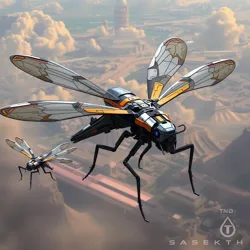Dragonfly Transport Fleet

The Dragonfly Transport Fleet (DTF) is a revolutionary system of biomechanical cargo carriers developed in 2159 by Aeronautics Synthesis Corporation. These massive synthetic insects, inspired by dragonfly anatomy, serve as the backbone of modern aerial micro-logistics and precision delivery systems.
Technical Specifications
Each transport unit features a wingspan of 3 meters and incorporates crystalline wing technology that enables both high-speed cruise flight and precise hovering capabilities. Powered by advanced micro-fusion cores, these units can operate continuously for up to 72 hours without recharging.
Key Features
- Quantum navigation system
- Self-repairing wing membrane
- Neural-swarm coordination capabilities
- Adaptive cargo compartments
- Atmospheric condition sensors
Applications
Commercial Transport
The fleet primarily handles the transportation of sensitive materials requiring precise environmental control, including: - Medical supplies - Electronic components - Quantum computing cores - Biological specimens
Environmental Monitoring
DTF units are equipped with sophisticated sensors that collect atmospheric data during transport operations, contributing to global weather monitoring networks and synthetic ecosystem management.
Fleet Organization
The fleet operates in standardized formations called "Wings," each consisting of 12 transport units coordinated by a central hive intelligence node. Multiple Wings can combine to form "Swarms" for larger cargo operations.
Recent Developments
Recent upgrades have introduced enhanced quantum communication arrays and improved cargo capacity through advanced materials science. The latest Mark VII units can carry payloads up to 50 times their body weight while maintaining optimal flight efficiency.
See Also
- Synthetic Insect Logistics
- Biomechanical Flight Systems
- Cargo Swarm Networks
References
- Advanced Transport Monthly
- Synthetic Biology Review
- Biomechanical Engineering Digest